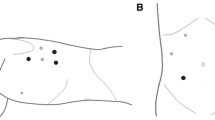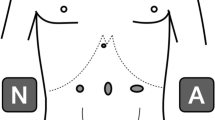Abstract
Background
This retrospective single-institution study presents a successful treatment strategy for Boerhaave’s syndrome.
Methods
During 1995–2008, 15 patients with spontaneous esophageal perforation were treated. Patients were grouped according to time from symptoms to referral (early, <24 h; late, >24 h). In group I (early, n = 8 patients) treatment comprised primary surgical esophageal repair in seven cases and endoscopic clipping in one case. In group II (late, n = 7 patients) treatment comprised esophagectomy without primary reconstruction (4 cases) or controlled esophagocutaneous fistula (3 cases). Measures of outcome included age (years), delay to diagnosis (h), severe sepsis on admission, mortality, and hospital and intensive care unit (ICU) stay.
Results
The overall hospital mortality rate was 6.6% (1/15), being 0% (0/8) in group I and 14.2% (1/7) in group II. Patient age (49.6 vs. 68.6 years, P < 0.0001), delay to diagnosis (17.75 vs. 69 h, P < 0.0001), severe sepsis on admission (0 vs. 4, P = 0.0256), and ICU stay (4 vs. 14 days, P = 0.006) were all greater in group II.
Conclusions
Early diagnosis and carefully selected therapeutic tactics can reduce the mortality rate of Boerhaave’s syndrome to an acceptably low level. Methods of organ preservation and minimally invasive techniques can be applied successfully in the treatment.
Similar content being viewed by others
References
Bufkin BL, Miller JI Jr, Mansour KA (1996) Esophageal perforation: emphasis on management. Ann Thorac Surg 61:447–1452
Sakamoto Y, Tanaka N, Furuya T, Ueno T, Okamoto H, Nagai M, Murakawa T, Takayama T, Mafune K, Makuuchi M, Nobori M (1997) Surgical management of late esophageal perforation. Thorac Cardiovasc Surg 45:269–272
Skinner DB, Little AG, DeMeester TR (1988) Management of esophageal perforation. Am J Surg 139:760–764
Tilanus HW, Bossuyt P, Schattenkerk ME, Obertrop H (1991) Treatment of esophageal perforation: a multivariate analysis. Br J Surg 78:582–585
Boerhaave H (1724) Atrocis, nec descripti pruis, morbi historia. Secundum medicae artis leges consripta Lugduni Batavorum Boutesteniana. English translation: Derbes VJ, Mitchell RE (1955) Bull Med Libr Assoc 43:217–240
Altorjay Á, Kiss J, Vörös A, Szirányi E (1998) The role of esophagectomy in the management of esophageal perforations. Ann Thorac Surg 65:1433–1436
Besznyák I, Szántó K, Balogh Á (1973) A Boerhaave-szindrómáról. Orv Hetil 114:629–630
Bone RC, Balk RA, Cerra FB, Dellinger RP, Fein AM, Knaus WA, Schein RM, Sibbald WJ (1992) Definitions for sepsis and organ failure and guidelines for the use of innovative therapies in sepsis. The ACCP/SCCM Consensus Conference Committee. Am Coll Chest Physicians/Soc Crit Care Med Chest 101:1644–1655
Giménez A, Franquet T, Erasmus JJ, Martínez S, Estrada P (2002) Thoracic complications of esophageal disorders. Radiographics 22:S247–S258
Fadoo F, Ruiz DE, Dawn SK, Webb WR, Gotway MB (2004) Helical CT esophagography for the evaluation of suspected esophageal perforation or rupture. AJR Am J Roentgenol 182:1177–1179
Barrett NR (1947) Report of a case spontaneous perforation of the esophagus successfully treated by operation. Br J Surg 35:216–218
Attar S, Hankins JR, Suter CM, Coughlin TR, Sequeira A, McLaughlin JS (1990) Esophageal perforation: a therapeutic challenge. Ann Thorac Surg 50:45–51
Lawrence DR, Ohri SK, Moxon RE, Townsend ER, Fountain SW (1999) Primary esophageal repair for Boerhaave’s syndrome. Ann Thorac Surg 67:818–820
Sabanath S, Eng J, Richardson J (1994) Surgical management of intrathoracic esophageal rupture. Br J Surg 81:863–865
Grillo HC, Wilkins EW (1975) Esophageal repair following late diagnosis of intrathoracic perforation. Ann Thorac Surg 20:387–399
Richardson JD, Martin LF, Borzotta AP, Polk HC (1985) Unifying concepts in the treatment of esophageal leaks. Am J Surg 149:157–162
Brewer LA, Carter R, Mulder GA, Stiles QR (1986) Options in the management of perforations of the esophagus. Am J Surg 152:62–69
Jara FM (1979) Diaphragmatic pedicle flap for treatment of Boerhaave’s syndrome. J Thorac Cardiovasc Surg 78:931–933
Mathisen DJ, Grillo HC, Vlahakes GJ, Daggett WM (1988) The omentum in the management of complicated cardiothoracic problems. J Thorac Cardiovasc Surg 95:677–684
Bardaxoglou E, Campion JP, Landen S, Manganas D, Siriser F, Chareton B, Launois B (1994) Esophageal perforation: primary suture repair reinforced with absorbable mesh and fibrin glue. Br J Surg 81:399
Orringer MB, Stirling MB (1990) Esophagectomy for esophageal disruption. Ann Thorac Surg 49:35–42
Kiss J (2008) Surgical treatment of esophageal perforation. Br J Surg 95:805–806
Matthews HR, Mitchell IM, McGuigan JA (1989) Emergency subtotal esophagectomy. Br J Surg 76:918–920
Urschel HC Jr, Razzuk MA, Wood RE, Galbraith N, Pockey M, Paulson DL (1974) Improved management of esophageal perforation: exclusion and diversion in continuity. Ann Surg 179:587–591
Abbot OA, Mansour KA, Logan WD Jr, Symbas PN (1970) Atraumatic so-called “spontaneous” rupture of the esophagus. J Thorac Cardiovasc Surg 59:67–83
Gouge TH, Depan HJ, Spencer FC (1989) Experience with the Grillo pleural wrap procedure in 18 patients with perforation of the thoracic esophagus. Ann Surg 209:612–617
Santini M, Fiorello A, Cappabianca S, Vicidomini G (2007) Unusual case of Boerhaave syndrome, diagnosed late and successfully treated by Abbott’s T-tube. J Thorac Cardiovasc Surg 134(2):539–540
Sarr MD, Pemberton JH, Payne WS (1982) Management of instrumental perforations of the esophagus. J Thorac Cardiovasc Surg 84:211–218
Landen S, El Nakadi I (2002) Minimally-invasive approach to Boerhaave’s syndrome: a pilot study of three cases. Surg Endosc 16:1354–1357
Scott HJ, Rosin RD (1995) Thoracoscopic repair of a transmural rupture of the esophagus. J R Soc Med 88:414–415
Fiscon V, Portale G, Frigo F, Migliorini G, Fania PL (2010) Spontaneous rupture of middle thoracic esophagus: thoracoscopic treatment. Surg Endosc 24(11):2900–2902
Dapri G, Dumont H, Roman A, Stevens E, Himpens J, Cadiere GB (2008) A delayed Boerhaave’s syndrome diagnosis treated by thoracoscopy in prone position. Minerva Chir 63:237–240
Ashrafi AS, Awais O, Alvelo-Rivera M (2007) Minimally invasive management of Boerhaave’s syndrome. Ann Thorac Surg 83:317–319
Vaidya S, Prabhudessai S, Jhawar N, Patankar RV (2010) Boerhaave’s syndrome: thoracolaparoscopic approach. J Minim Access Surg 6(3):76–79
Toelen C, Hendrickx L, van Hee R (2007) Laparoscopic treatment of Boerhaave’s syndrome: a case report and review of the literature. Acta Chir Belg 107(4):402–404
Fischer A, Thomusch O, Benz S, von Dobschuet Z, Baier P, Hopt U (2006) Non- operative treatment of 15 benign esophageal perforations with self-expandable covered metal stents. Ann Thorac Surg 81:467–472
Johnsson E, Lundell L, Liedman B (2005) Sealing of esophageal perforation or ruptures with expandable metallic stents: a prospective controlled study on treatment efficacy and limitations. Dis Esophagus 18:262–266
Wewalka FW, Clodi PH, Haidinger D (1995) Endoscopic clipping of esophageal perforation after pneumatic dilation for achalasia. Endoscopy 27:608–611
Cipolletta L, Biano MA, Rotondano G, Marmo R, Piscopo R, Meucci C (2000) Endoscopic clipping of perforation following pneumatic dilation of esophagojejunal anastomotic strictures. Endoscopy 32:720–722
Raymer GS, Sadana A, Campbell DB, Rowe WA (2003) Endoscopic clip application as an adjunct to closure of mature esophageal perforation with fistulae. Clin Gastroenterol Hepatol 1:44–50
Shimizu Y, Kato M, Yamamoto J, Nakagawa S, Komatsu Y, Tsukagoshi H, Fujita M, Hosokawa M, Asaka M (2004) Endoscopic clip application for closure of esophageal perforations caused by EMR. Gastrointest Endosc 60:636–639
Sriram PV, Rao GV, Reddy ND (2006) Successful closure of spontaneous esophageal perforation (Boerhaave’s syndrome) by endoscopic clipping. Indian J Gastroenterol 25:39–41
Qadeer MA, Dumot JA, Vargo JJ, Lopez AR, Rice TW (2007) Endoscopic clips for closing esophageal perforations: case report and pooled analysis. Gastrointestinal 66:605–611
Fiscon V, Portale G, Fania P, Duodeci S, Frigo F, Migliorini G (2008) Successful minimally invasive repair of spontaneous esophageal perforation. J Laparoendosc Adv Surg Tech A 18(5):721–722
Loske G, Schorsch T, Müller C (2010) Endoscopic vacuum sponge therapy for esophageal defects. Surg Endosc 24(10):2531–2535
Loske G, Schorsch T, Müller C (2010) Endoscopic intracavitary vacuum therapy of Boerhaave’s syndrome: a case report. Endoscopy Suppl 2:E144–E145
Bisgaard T, Wojdemann M, Heindorff H, Svendsen LB (1997) Nonsurgical treatment of esophageal perforations after endoscopic palliation in advanced esophageal cancer. Endoscopy 29:155–159
Chambers AS, Jordan T, McGranahan T, Kiev J (2005) A new management approach for esophageal perforation. J Thorac Cardiovasc Surg 130:1470–1471
Dormann AJ, Wigginghaus B, Deppe H, Huchzermeyer H (2001) Successful treatment of esophageal perforation with a removable self-expanding plastic stent. Am J Gastroenterol 96:923–924
Liedman B, Johnsson E, Lundell L (2001) Treatment of iatrogenic perforations with covered stents in patients with esophageal cancer. Eur J Surg 167:672–674
Segalin A, Bonavina L, Lazzerini M, De Ruberto F, Faranda C, Peracchia A (1996) Endoscopic management of inveterate esophageal perforations and leaks. Surg Endosc 10:928–932
Serna DL, Vovan TT, Roum JH, Brenner M, Chen JC (2000) Successful nonoperative management of delayed spontaneous esophageal perforation in patients with human immunodeficiency virus. Crit Care Med 28:2634–2637
Griffin SM, Lamb PJ, Shenfine J, Richardson DL, Karat D, Hayes N (2008) Spontaneous rupture of the esophagus. Br J Surg 95:1115–1120
Disclosures
György Lázár, Attila Paszt, Zsolt Simonka, Anett Bársony, Szabolcs Ábrahám, and Gábor Horváth have no conflicts of interest or financial ties to disclose.
Author information
Authors and Affiliations
Corresponding author
Rights and permissions
About this article
Cite this article
Lázár, G., Paszt, A., Simonka, Z. et al. A successful strategy for surgical treatment of Boerhaave’s syndrome. Surg Endosc 25, 3613–3619 (2011). https://doi.org/10.1007/s00464-011-1767-1
Received:
Accepted:
Published:
Issue Date:
DOI: https://doi.org/10.1007/s00464-011-1767-1




